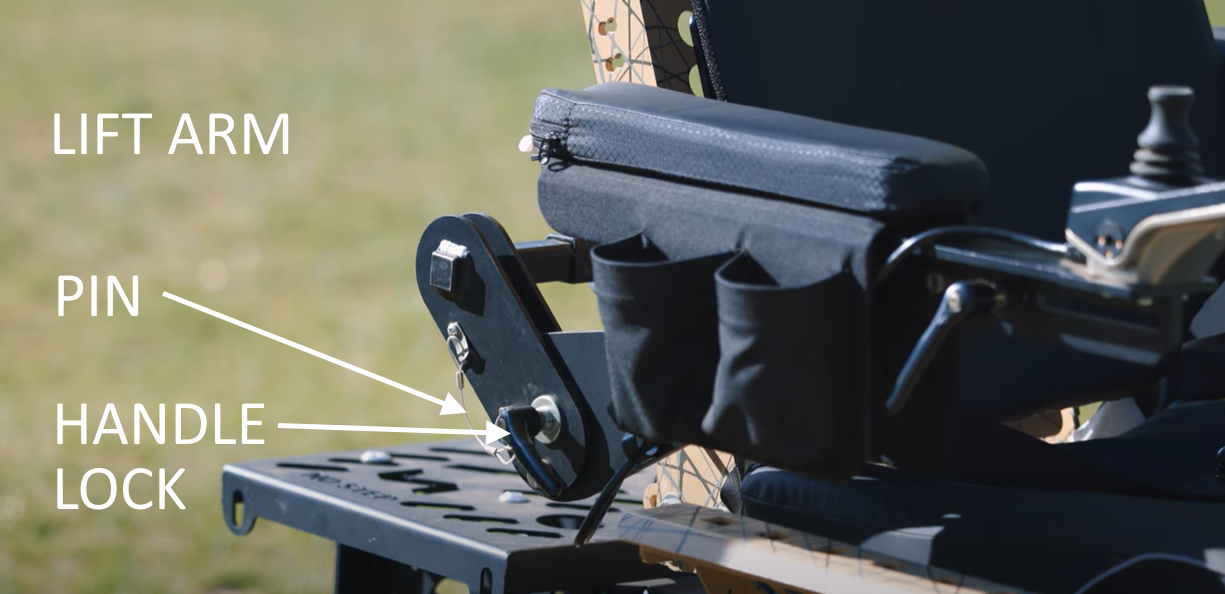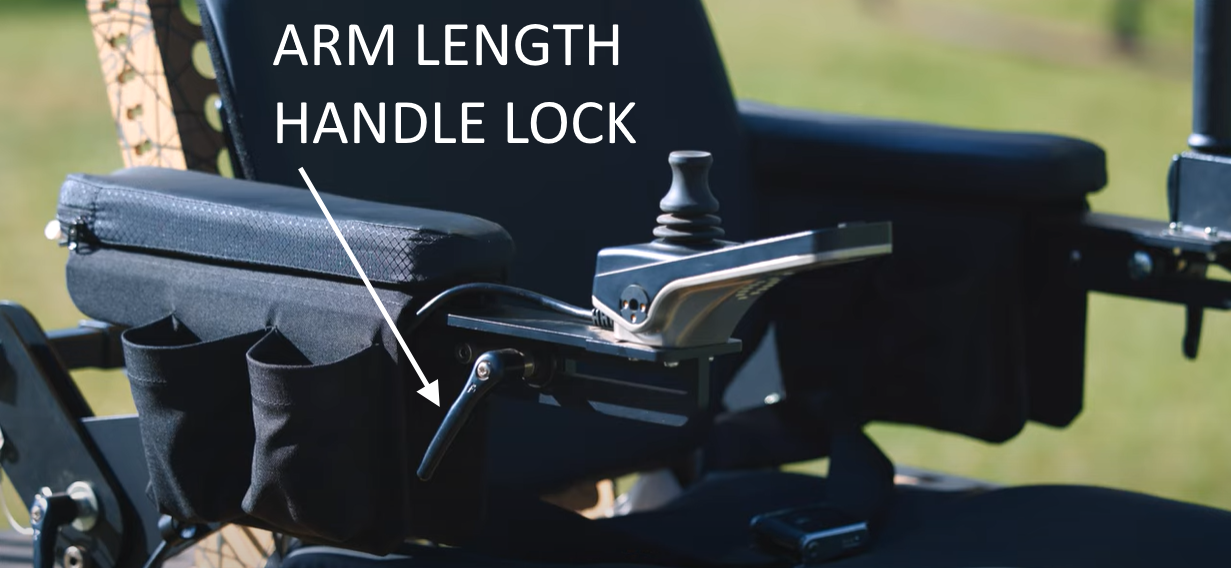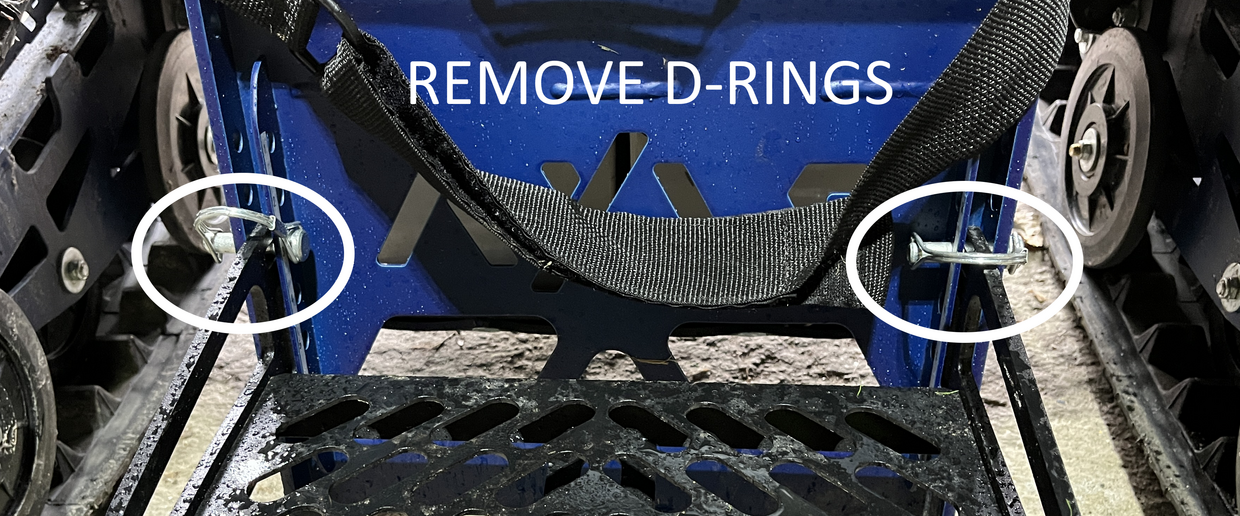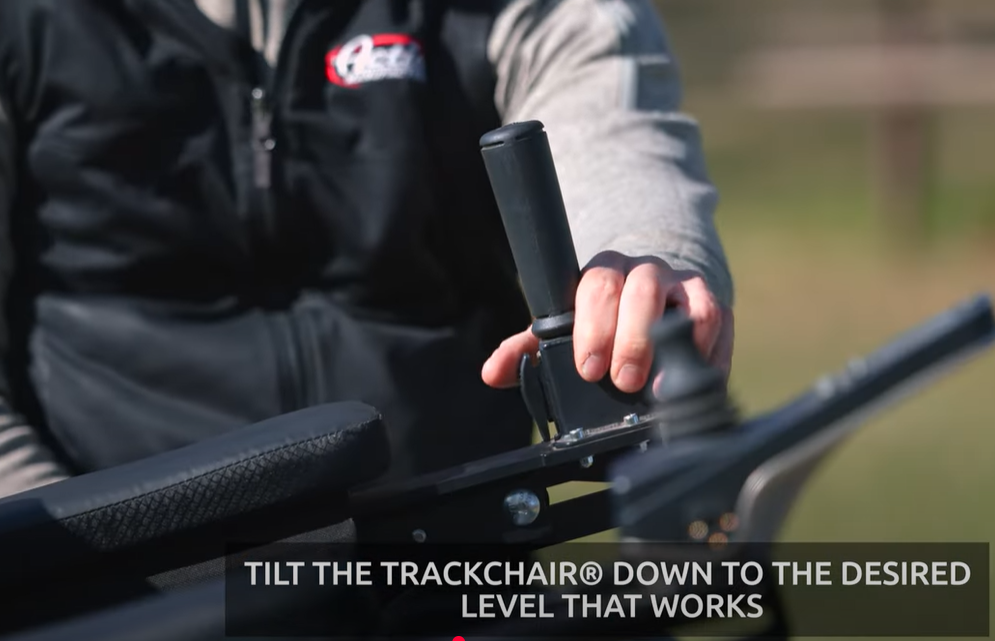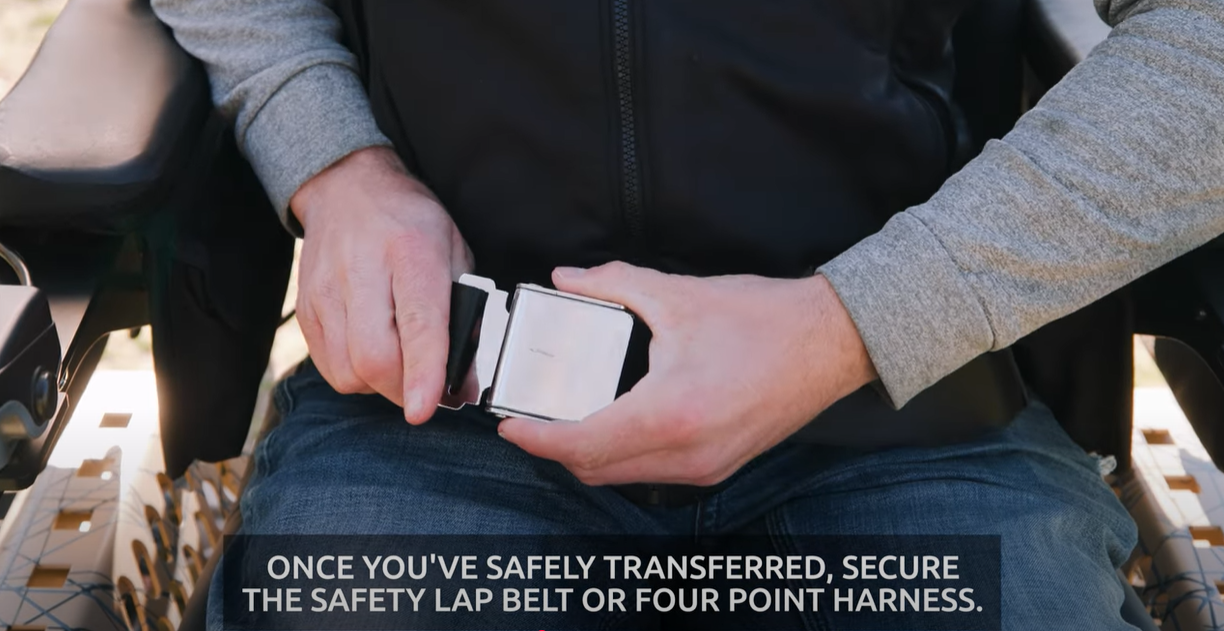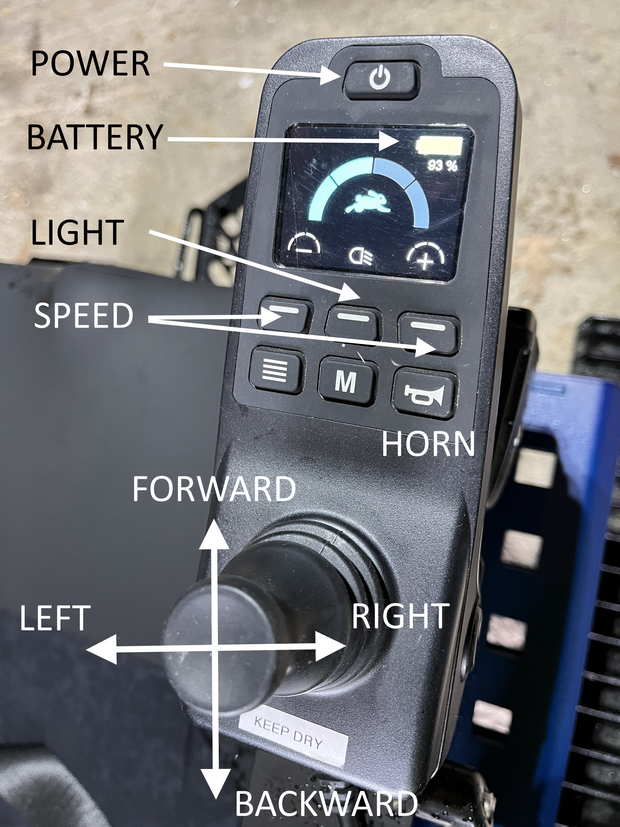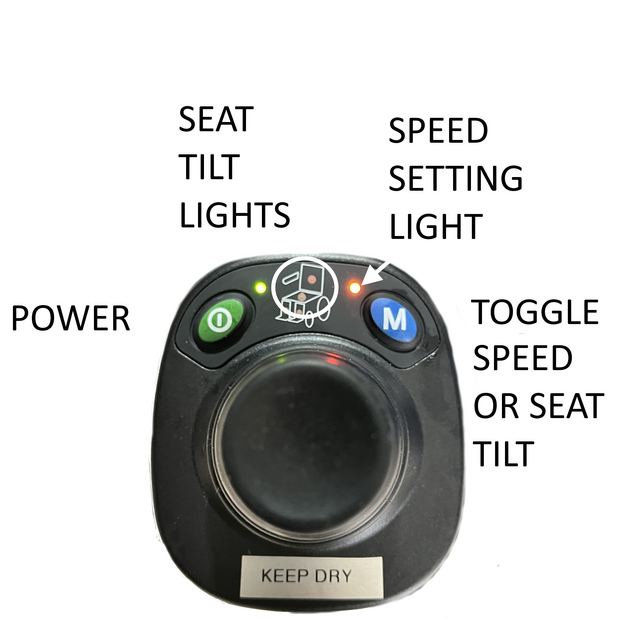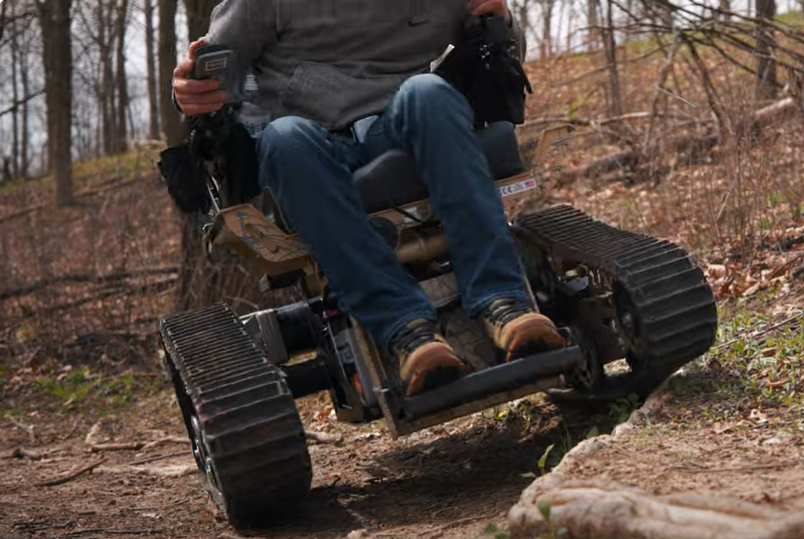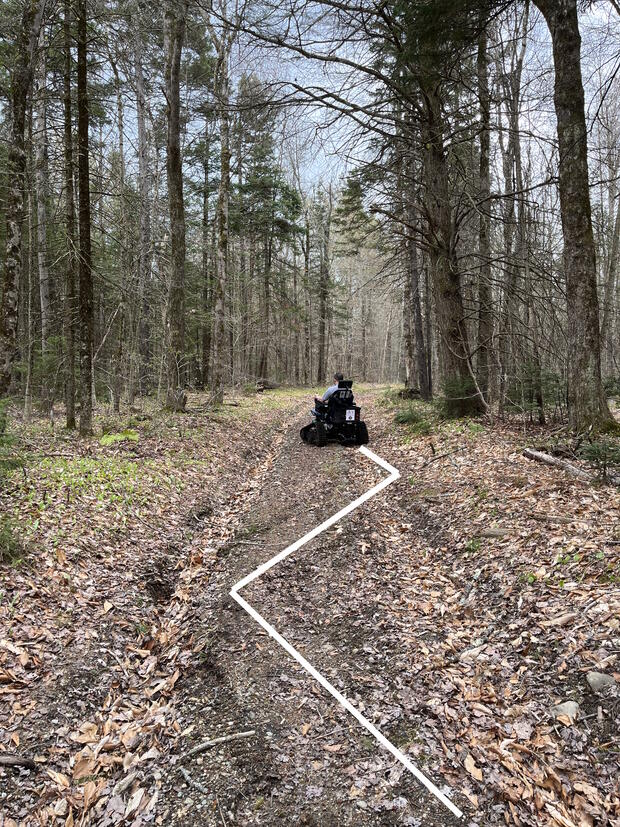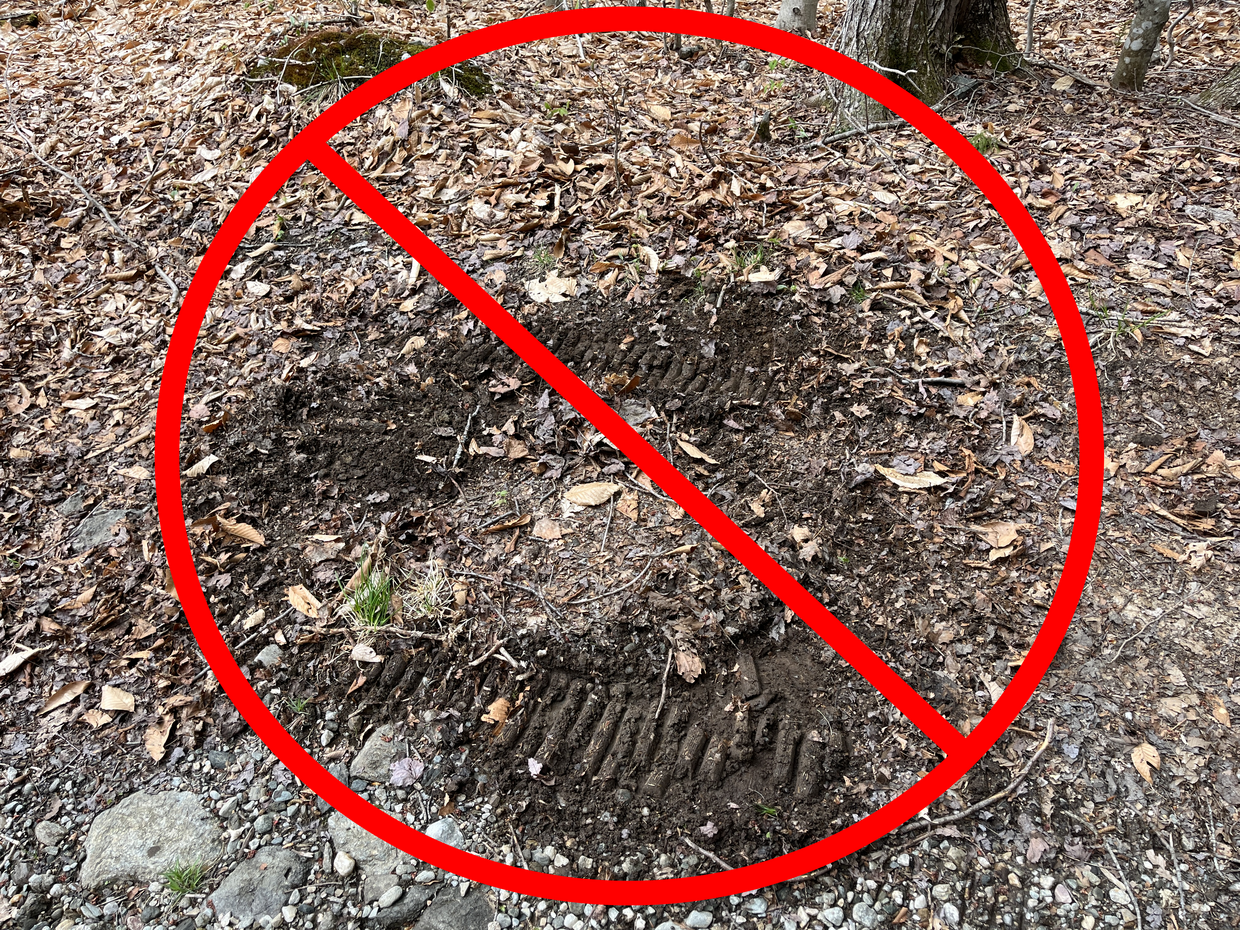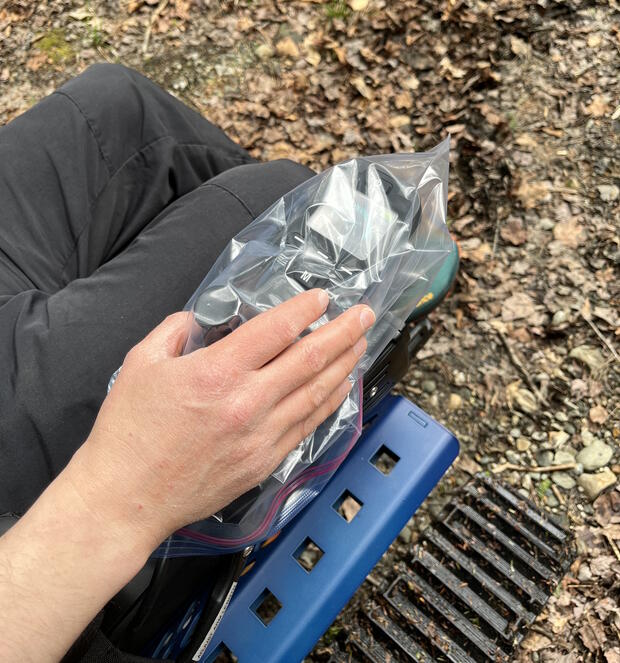Orientation video
Please watch the Action Trackchair AXIS Essential Operation Training video provided by the manufacturer.
Video: Action Trackchair® AXIS Essential Operation Training
Skip this video Action Trackchair® AXIS Essential Operation Training.Transfer and adjustments
Armrests
The armrests can move up to allow more room for transfer. To move the armrests up, locate the pin and handle lock located at the back of the armrest. Remove the pin and loosen the handle lock. Move the armrest up. After transferring, move the armrest down and secure by tightening the handle and reinserting the pin.
The length of the armrests can also be adjusted. Loosen the handle lock located on the outside of the armrest and pull it to the desired length.
To adjust the width of the armrests, unlock the thumb screws and remove the pins located on the rear of the back rest. Lift up on the front of the armrest to move it. Find the position that is most comfortable. Line up the holes, put the pin back in, and tighten the thumb screw. The numbers on the holes will help you remember the adjustment that is most comfortable for you on your next visit.
Headrest
The headrest can be adjusted to provide head support if needed. To adjust the height of the headrest, loosen the thumbscrew on the back of the seat. To adjust the headrest back and forth, loosen the thumbscrew on the back of the headrest. After you have found a comfortable position, tighten the thumbscrews.
Footrest
The height of the footrest can be adjusted depending on the length of your legs. Unlock the D-rings on either side of the footrest and remove them. Slide the footrest to the desired height, lining up the top hole in the footrest with one of the numbered holes on the front of the Trackchair. Secure the footrest by inserting the D-rings and locking them. The numbers on the holes will help you remember the adjustment that is most comfortable for you on your next visit. The Velcro strap on the footrest can be wrapped around your legs to keep them in place. At the lowest setting, the footrest will be just above the ground. Please tilt the Trackchair back far enough to get enough clearance while riding on the trails.
Transfers
Power up the Trackchair by pressing the power button on the hand control module.
Use the seat tilt switch at the base of the hand support on the left-hand side to tilt the Trackchair down to the desired level that works best with the wheelchair you are transferring from. Once the Trackchair has been tilted down, power the Trackchair off to make sure the drive system is not accidentally engaged during the transfer process. Never get into the Trackchair while it is powered on, regardless of your level of mobility or how you are getting into the Trackchair.
DCR staff cannot assist with transfers, maneuvering, or chair adjustments.
You can borrow a transfer board to help with transfers. You can also borrow straps, cushions, and foam wedges to help get comfortable in the Trackchair, and a small adjustable umbrella to shade you from the sun. You are also welcome to bring personal comfort items like blankets, cushions or pillows to sit on or to go behind your back, and additional straps for securing your feet, arms, or upper body.
Seatbelt and harness
Once you have safely transferred, secure the safety lap belt. All users are required to wear their safety belt at all times. To fasten the lap belt, insert the tongue into the buckle. Then, tighten the belt on the buckle side until it is snug. If you need a longer belt, use the 9”-long seatbelt extension.
To use the four-point safety harness in addition to the lap belt, slip your arms through each hole and fasten the two buckles in the middle. Adjust the fit of the harness at each shoulder, each hip, and next to each of the buckles in the middle. If you are not using the harness, it can be tucked behind the seat and stored in the basket on the back of the track chair.
Safety
The Action Trackchair AXIS is rated to climb slopes up to 25° of incline (45% slope). The Trackchair will climb inclines enough to tip over in any direction. Always ride within your abilities and do not attempt to climb slopes you are uncertain about. When approaching inclines or declines always use caution and switch to a slower speed. Do not attempt to climb stairs, natural or otherwise.
Be aware of your surroundings at all times, especially when going in reverse. Always stay on the designated trails.
The weight limit of the AXIS is 300 pounds. This limit includes you and any gear you are carrying in the chair. The utility rack at the back of the Trackchair has bungee cords to hold your belongings. The utility rack can support up to 90 pounds.
Only one person is allowed on the chair at a time. You must not let people or animals sit in your lap, ride the chair with you, or pull on the chair when it is in motion.
Keep hands and fingers away from the rotating parts of the tracks and pinch points.
Leashes, long clothing, blankets, or other dangling items (e.g. backpack straps, camera straps) are at risk of becoming entangled in the tracks. Please be aware of dangling items and use caution. We recommend that your companion hold leashes whenever possible to keep them clear of the device.
Users aged 16 or younger must wear a safety helmet like a bike helmet while riding in the Trackchair, You will need to bring your own helmet.
Notify DCR staff immediately of any malfunctions, collisions, or other issues with the Trackchair.
Operation
The joystick to steer the Trackchair while you are riding in it is mounted on the right-hand side. If you can’t use this joystick, your companion can control the chair with an attendant control on the back of the chair. If you want to steer the chair yourself but need a joystick on the left side, contact the Universal Access Program to explore options for independent control of the chair.
Rider control
Power on the Trackchair by pressing the power button located at the top of the hand control. The Trackchair will boot up and display the action Trackchair logo. Tap the joystick forward to enter drive mode. Speed adjustments through the eleven speed settings can be made by pressing the buttons indicated by the plus and minus signs: plus to increase, minus to decrease.
To drive forward, push the joystick forward. To drive backwards, push the joystick backward. To stop, let off the joystick. Please note that it will take a few feet for the Trackchair to come to a complete stop. The faster you are going, the longer it will take to stop.
To operate a zero-turn left-hand turn, push the joystick left at 90°. To operate a zero-turn right-hand turn, push the joystick right at 90°. To stop, let go of the joystick.
To activate the headlight, press the middle button located on the top row on the hand control. To activate the horn, press the horn button. Battery life is indicated in the top right-hand corner.
Seat tilt switch
The seat tilt switch is located at the base of the hand support on the left side of the chair. This switch allows you to tilt on the fly while still operating the Trackchair.
Attendant control
The attendant control on the back of the Trackchair lets your companion control the chair. Once the attendant control is turned on, the hand control on the right will no longer work. Please leave the joystick cover over the joystick you are not using to keep it clean and dry.
Press the green power button on the joystick and wait a few seconds for the attendant control to turn on. Tap the joystick forward to enter drive mode. You can toggle between two speed settings by pressing the M button. A green light indicates the lower speed setting, an orange light indicates the higher speed setting, and no light indicates the drive mode isn’t engaged. You can tilt the chair using the attendant control by toggling the M button until green lights are displayed on the seat area. Move the joystick forward or backward to tilt the chair. To turn the chair off, press the green power button and wait six seconds.
Driving tips
When approaching an obstacle along your path, like a stump, log, or rock, direct your left or right track to directly encounter the obstacle to avoid high centering. Do not try to clear the obstacle. Remember to always put a track on it.
When approaching a steep incline, maneuver using a zigzag pattern. Tilt the seat backwards to allow for enough clearance at the base of the footrest. When ascending, tilt the Trackchair forward. When descending, tilt the Trackchair backwards. Making this tilt adjustment will move your center of gravity, resulting in a more comfortable ride.
Respect the surface or trail you are on by avoiding sudden turns and zero turns. Continuous zero turning will damage the ground and may cause a track to slip from the drive wheel.
The Trackchair is rated to operate in up to 10 inches of water and can drive through puddles or be used at the water’s edge for fishing. Do not submerge the Trackchair in water. Do not get the joystick wet. Keep the joystick bag secured over whichever joystick is not being used. In the event of rain, immediately take out the plastic bag and cover the joystick you are using. You can steer through the plastic bag.
Other features
The arms include four fabric cupholders and two Velcro closure pockets for storage. Please check the pockets when you are done using the Trackchair to remove any belongings. DCR isn’t responsible for personal items left behind in the Trackchair.
You can use the dual USB charging port on the front of the chair to charge your devices during your ride.
Keeping the chair clean
Please do not smoke or vape while riding in the Trackchair. Please apply bug spray and spray sunblock before you get in the chair. If you need to re-apply while you are on the trail, please spray the product into your hand and rub it on instead of spraying.
Courtesy, ethics, and the environment
- Be courteous of other trail users.
- Share the trail. Give non-motorized trail users the right of way.
- Keep right unless passing.
- When passing others, alert them with an audible signal such as by voice, bell, or horn.
- Travel at a reasonable speed. The maximum speed allowed on power-driven mobility devices is 5 miles per hour.
- Yield the right of way to those passing you from behind or traveling uphill.
- Stay on designated trails. Riding off the trail damages wildlife habitat and contributes to erosion.
- Keep noise down.
- Do not litter. Carry in, carry out all trash and belongings.
Sharing trails with horses
Horses’ natural instincts can influence their behavior and affect the way they react to circumstances encountered on the trail. Meeting a Trackchair or a mobility scooter may be a new experience for a horse. Please follow these guidelines when meeting a horse on the trail.
- Pull to the side of the trail far enough for horses to pass safely as soon as you see them.
- Pull to the downhill/lower side of the trail if possible. Horses tend to see unknown threats on the uphill side as predators.
- Speak to the rider and horse in a friendly, relaxed tone.
- When approaching horses from behind, stop. Call ahead and make yourself known to the rider. Ask them if it is OK to pass and the best way to do so.
- Riders might pull to the side of the trail if they hear you coming, but this doesn’t mean it is safe for you to ride by. Stop and wait for instructions from the horse rider.
- Ask the horse rider what they would like to do. The horse rider will know their horse and how they react.
- The horse rider may ask you to stop so they can ride past you.
- The horse rider may stay to the side of the trail and ask you to pass them.
- If you pass a horse, keep your speed low and steady and your sound as low as possible. Sudden movements or sounds can startle horses.
- Be alert, aware, and on guard for oncoming hikers or horses while you are passing.
Reservations
Thank you for reviewing these instructions. You can now make a reservation to use the chair online. The reservation code is 112358.
Make a reservation to use the Trackchair at Maudslay State Park. Available dates: May 12–June 8 & September 5–October 31, 2025
Make a reservation to use the Trackchair at Windsor State Forest. Available dates: June 13–September 1, 2025.
Questions or concerns
If you have any questions or concerns about the Trackchair, or are having trouble making a reservation using the online form, please contact the Universal Access Program at DCR.UniversalAccess@mass.gov or (413) 461-7126.
